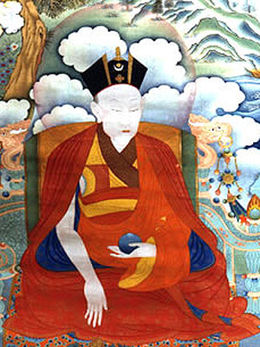
Rolpe Dorje
Encyclopedia

Rolpe Dorje (1340–1383) was the fourth Gyalwa Karmapa
Karmapa
The Karmapa is the head of the Karma Kagyu, the largest sub-school of the Kagyupa , itself one of the four major schools of Tibetan Buddhism....
. According to legend the fourth Karmapa's mother, while pregnant, could hear the sound of the mantra Om Mani Padme Hum
Om mani padme hum
is the six syllabled mantra particularly associated with the four-armed Shadakshari form of Avalokiteshvara , the bodhisattva of compassion...
while the child was in her womb and the baby said the mantra as soon as he was born. His early life was full of miracles and manifested a total continuity of the teachings and qualities of his former incarnation, including receiving teachings in his dreams. While in his teens, he received the formal transmissions of both the Kagyu
Kagyu
The Kagyu, Kagyupa, or Kagyud school, also known as the "Oral Lineage" or Whispered Transmission school, is today regarded as one of six main schools of Himalayan or Tibetan Buddhism, the other five being the Nyingma, Sakya, Jonang, Bon and Gelug...
and Nyingma
Nyingma
The Nyingma tradition is the oldest of the four major schools of Tibetan Buddhism . "Nyingma" literally means "ancient," and is often referred to as Nga'gyur or the "old school" because it is founded on the first translations of Buddhist scriptures from Sanskrit into Tibetan, in the eighth century...
lineages from the great Nyingma guru Yungtönpa, the third Karmapa
Rangjung Dorje
Rangjung Dorje was the third Karmapa, an important figure in the history of Tibetan Buddhism. He reportedly produced a spontaneous black crown at the age of three and declared himself to be the mindstream reimbodiment of Karma Pakshi...
's spiritual heir, now very advanced in years. At the age of nineteen, he accepted Toghon Temur's invitation to return to China
China
Chinese civilization may refer to:* China for more general discussion of the country.* Chinese culture* Greater China, the transnational community of ethnic Chinese.* History of China* Sinosphere, the area historically affected by Chinese culture...
where he gave teachings for three years and established many temples and monasteries.
On his return to Tibet
Tibet
Tibet is a plateau region in Asia, north-east of the Himalayas. It is the traditional homeland of the Tibetan people as well as some other ethnic groups such as Monpas, Qiang, and Lhobas, and is now also inhabited by considerable numbers of Han and Hui people...
, while in the Tsongkha region, Rolpi Dorje gave lay ordination to a very special child, whom he predicted to be of great importance to Buddhism in Tibet. This was Tsong Khapa
Je Tsongkhapa
Tsongkhapa , whose name means “The Man from Onion Valley”, was a famous teacher of Tibetan Buddhism whose activities led to the formation of the Geluk school...
, the future founder of the Gelugpa school, famous for its Dalai Lama
Dalai Lama
The Dalai Lama is a high lama in the Gelug or "Yellow Hat" branch of Tibetan Buddhism. The name is a combination of the Mongolian word далай meaning "Ocean" and the Tibetan word bla-ma meaning "teacher"...
s.
When Temur died, the Mongol dynasty ended and the Ming dynasty
Ming Dynasty
The Ming Dynasty, also Empire of the Great Ming, was the ruling dynasty of China from 1368 to 1644, following the collapse of the Mongol-led Yuan Dynasty. The Ming, "one of the greatest eras of orderly government and social stability in human history", was the last dynasty in China ruled by ethnic...
began. The new emperor invited Rolpi Dorje, who declined the invitation but sent another lama
Lama
Lama is a title for a Tibetan teacher of the Dharma. The name is similar to the Sanskrit term guru .Historically, the term was used for venerated spiritual masters or heads of monasteries...
in his stead. Rolpi Dorje composed mystic songs throughout his life and was an accomplished poet, fond of Indian poetics. He is also remembered for creating a huge painting (thangka
Thangka
A "Thangka," also known as "Tangka", "Thanka" or "Tanka" is a Tibetan silk painting with embroidery, usually depicting a Buddhist deity, famous scene, or mandala of some sort. The thankga is not a flat creation like an oil painting or acrylic painting...
) following a vision of one of his students, who had imagined a Buddha image over a 100 metres tall. The Karmapa, on horseback, traced the Buddha's outline with hoofprints. The design was measured and traced on cloth. It took 500 workers more than a year to complete the thangka, which depicted the Buddha
Gautama Buddha
Siddhārtha Gautama was a spiritual teacher from the Indian subcontinent, on whose teachings Buddhism was founded. In most Buddhist traditions, he is regarded as the Supreme Buddha Siddhārtha Gautama (Sanskrit: सिद्धार्थ गौतम; Pali: Siddhattha Gotama) was a spiritual teacher from the Indian...
, Maitreya
Maitreya
Maitreya , Metteyya , or Jampa , is foretold as a future Buddha of this world in Buddhist eschatology. In some Buddhist literature, such as the Amitabha Sutra and the Lotus Sutra, he or she is referred to as Ajita Bodhisattva.Maitreya is a bodhisattva who in the Buddhist tradition is to appear on...
and Manjusri
Manjusri
Mañjuśrī is a bodhisattva associated with transcendent wisdom in Mahāyāna Buddhism. In Esoteric Buddhism he is also taken as a meditational deity. The Sanskrit name Mañjuśrī can be translated as "Gentle Glory"...
; the founders of Mahayana
Mahayana
Mahāyāna is one of the two main existing branches of Buddhism and a term for classification of Buddhist philosophies and practice...
.


